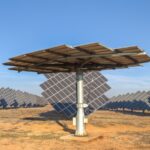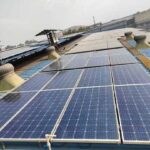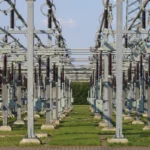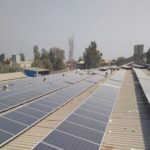Solar Net Metering in Industrial Units: Opportunities and Risks
Solar Net Metering in Industrial Units: Opportunities and Risks
Discoms in almost all the states provide Solar Net Metering facility by which the consumers can store the excess energy generated from the roof top solar plant with the Discom Grid and can use it in later hours.
During the Sun hours, when the load (in KW) of the factory or the commercial building is less than the roof top solar generation for any 15-minute block interval, the excess solar energy goes back to the Grid. During evening hours when the load is more and there is hardly any solar generation, then the stored solar energy is used back by the consumer from the Grid.
Steps of accounting of the roof top solar energy (Solar Net Metering)
The accounting of the roof top solar energy is done on a monthly basis.
- At the end of each month, the solar energy is set off against the energy consumed by the factory or the Plant through a bi-directional meter installed by the Discom at the Consumer premises.
- If there is any excess solar energy which is not used during the month, it is taken forward to the next month in which the consumer can use the same.
- However, if there is unused solar energy left in March (end of Financial Year), then it will lapse as per the policy in Haryana while it will be paid at Rs 2.0 /kWh in Uttar Pradesh. Similar policies exist in other states also including Delhi, Rajasthan and Punjab.
The table below shows the energy accounting and settlement for 1 month (April) under Solar Net Metering for a 100 KW solar system in a typical factory set up with a contract demand of 100 KW.
| Day | Energy Consumed(kWh) | Solar Generation)(kWh) | Banked Energy |
| 1 | 614 | 479 | – |
| 2 | 15 | 478 | 463 |
| 3 | 478 | 491 | 13 |
| 4 | 645 | 444 | – |
| 5 | 633 | 450 | – |
| 6 | 701 | 441 | – |
| 7 | 612 | 520 | – |
| 8 | 426 | 523 | 97 |
| 9 | 12 | 541 | 529 |
| 10 | 459 | 497 | 38 |
| 11 | 723 | 478 | – |
| 12 | 578 | 483 | – |
| 13 | 623 | 429 | – |
| 14 | 701 | 501 | – |
| 15 | 641 | 504 | – |
| 16 | 12 | 502 | 490 |
| 17 | 423 | 476 | 53 |
| 18 | 530 | 472 | – |
| 19 | 481 | 451 | – |
| 20 | 392 | 439 | 47 |
| 21 | 543 | 472 | – |
| 22 | 605 | 462 | – |
| 23 | 12 | 495 | 483 |
| 24 | 452 | 523 | 71 |
| 25 | 545 | 547 | 2 |
| 26 | 393 | 482 | 89 |
| 27 | 479 | 477 | – |
| 28 | 625 | 461 | – |
| 29 | 521 | 441 | – |
| 30 | 12 | 478 | 466 |
| April | 13,886 | 14,437 | 551 |
For certain days in April month, the energy is getting banked or stored with the Discom. At the end of month, solar has generated excess of 551 kWh or units which will be taken forward to the month of May.
Table below shows monthly settlements for the full year of solar energy.
| Month | Energy Consumed(kWh) – (1) | Solar Generation)(kWh) – (2) | (2)-(1) (kWh) | (Cumulative Energy banked (kWh) |
| Apr | 13,886 | 14,437 | 551 | 551 |
| May | 15,672 | 15,432 | (240) | 311 |
| Jun | 14,521 | 13,441 | (1,080) | – |
| July | 12,673 | 11,699 | (974) | – |
| Aug | 11,128 | 10,952 | (176) | – |
| Sep | 11,893 | 11,699 | (194) | – |
| Oct | 12,321 | 11,450 | (871) | – |
| Nov | 11,009 | 9,210 | (1,799) | – |
| Dec | 10,121 | 8,463 | (1,658) | – |
| Jan | 10,344 | 8,712 | (1,632) | – |
| Feb | 11,236 | 11,201 | (35) | – |
| Mar | 11,037 | 13,690 | 2,653 | 2,653 |
So, there is excess solar generation in the months of April and March. However, the excess generation of April month is utilized in future months during the settlement year. But the excess solar generation in month of March will lapse in spite of solar Net Metering facility.
Especially for seasonal industries that has lean period during winter months, the coincidence of the settlement year with the financial year is a problem. For example, the potato cold storages (aloo godowns) has this typical problem as they hit a off season from October to February when their load dips significantly.
Suggested Articles

Higher Electricity Bills in Haryana as Fuel Surcharge Rises
Haryana consumers are facing higher electricity bills after the Haryana Electricity Regulatory Commission (HERC) approved a fuel surcharge hike for DHBVN and UHBVN areas. The increase reflects rising fuel and power purchase costs, directly impacting domestic, commercial, and industrial users across the state.

Solar Installation Cost in Haryana: Pricing, Savings & Subsidy Guide
Solar installation cost in Haryana varies by system size, components, and subsidy eligibility. This guide explains per-kW pricing, government incentives, and how much owners can save with rooftop solar in 2025, helping you choose the right system at the right budget.

6 Innovative Applications of Solar Energy You Should Know About
Explore how solar energy is revolutionizing daily life and industries. From solar-powered transport to smart cities, discover six groundbreaking solar applications shaping a cleaner, smarter future.

Solar Panel Sizes and Features in Delhi/NCR: A Complete Guide
Planning to install solar panels in Delhi/NCR? Explore the different sizes, technologies, and key features of solar panels available for residential, industrial, and commercial use. Learn how to choose the right one for your energy needs and roof space.

Haryana’s GEOA 2025: A Boost for Captive Solar Plants and Wind Energy Developers
Haryana’s GEOA 2025 paves the way for growth in captive wind and solar energy projects with investor-friendly reforms.

SmartRoof Solar Associate Program – Easy Way to Earn with Solar Referrals
Join the SmartRoof Solar Associate Program. Refer solar leads, earn rewards, and support clean energy growth in your community.
Researchers Propose New Way to Make Nuclear Power Plants Safer
Researchers propose innovative methods to enhance the safety of nuclear power plants, aiming to reduce risks and improve operational security.

Why Go Solar: A Complete Guide to Solar Power for Homes and Industries
Switching to solar energy offers significant savings and environmental benefits. This guide explains why going solar is a smart choice, covering financial incentives, reduced electricity bills, and positive impacts on the planet.